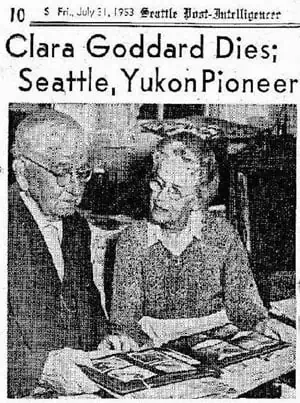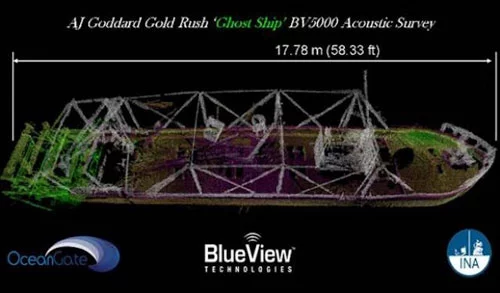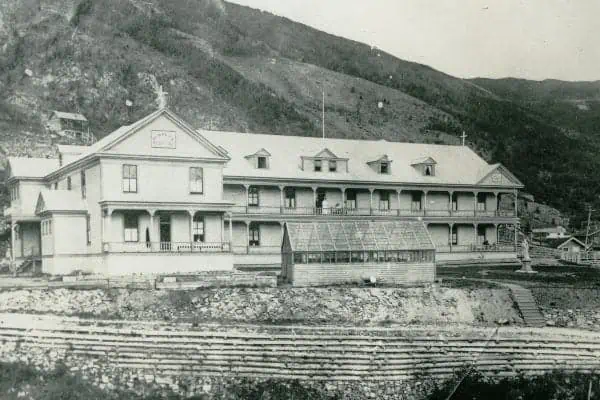She was not only the first female river pilot on the Upper Yukon, she was also the fastest.
No, her name wasn’t Klondike Kate, the Oregon Mare, Bombay Peggy or the (immortalized by Robert W. Service) “Lady that’s known as Lou.”
She and her husband Albert were in the fabrication and construction business in Seattle. It was July of 1897 when “ships laden with gold” arrived from a place called “The Clondyke” and all hell broke loose. Her name was Clara Goddard. Adney, London, Service, Berton and the rest of the writers and historians never heard of her because she was long gone before any of them put pens to paper. In fact, she only made one trip to Dawson, though it was a remarkable one …
The Goddards were the wealthy and successful owners of a foundry and steel fabrication business called Pacific Iron Works. It prospered greatly after the Great Seattle Fire of 1888 wiped out most of their competition.You could say the Klondike Gold Rush landed in their laps like a golden goose. They were perfectly situated, geographically and financially, to take advantage of it. Motivated by the combination of easy money and a grand adventure, Albert and Clara, along with Albert’s brother, Charles, immediately began making plans to build two “pocket paddlewheelers.” The ships would be pre-fabbed in their shipyards and shipped to both Dyea and Skagway. They would be assembled on the shores of Lake Bennett over the winter, with the goal of being ready to make steam for Dawson City as soon as the river and lakes were free of ice.
Albert bought two hulls from a San Francisco foundry and had them shipped to Skagway to be pulled by horses up White Pass to Lake Bennett. Everything else, including a pre-fab boiler of his own design, took the shortcut up the Chilkoot to Lake Lindemann. All the pieces were built small enough to be packed by men. It may sound like some kind of engineering marvel, but do-it-yourself steamboat kits were quite common in the late 19th century, though not in Alaska and the Yukon.
While the rest of the stampeders were whipsawing lumber, the Goddards set up a temporary shipyard on Lake Bennett. They had a company sign and a team of carpenters, millwrights and welders on hand to build two ships—the A.J. Goddard and the F.H. Kilbourne. Both were registered as Canadian vessels, Both were owned by Upper Yukon Company with Albert identified as navigator and Clara as captain or “skipper.”
The Goddard was finished first and was ready to work when the ice moved off Bennett on May 28, 1898. She made a trial run to Carcross on May 31, then to Tagish Post on June 2. She was stopped by ice on Marsh Lake before returning to Carcross and spending the next two weeks towing stampeders across Bennett and Tagish lakes for profit. On June 16, Sam Steele of the Mounted Police opened Marsh for navigation and she landed at Canyon City. Clara and Albert were co-pilots of the Goddard. They had 10 paying customers for that inaugural run to Dawson. They arrived at Whitehorse on June 17, but no mention was made anywhere in their records about who piloted the ship through her first run down Miles Canyon, the dangerous whirlpool and Whitehorse Rapids. They were the third steam-powered vessel to make it through and the first to arrive in Dawson in the early morning hours of June 21. Clara was in the pilot house when they docked at Dawson. Albert was giving hand signals and supervising the crew on deck.
Before they left for the return trip, Clara was honoured for being the first female paddlewheeler pilot on the Upper Yukon. The Goddard was recognized as the first ship to complete the Bennett to Dawson run during the Klondike Stampede, but it turned out to be her only round trip to Dawson. On the return voyage, the Goddard had trouble fighting the strong current at Five Finger Rapids. She spent the rest of the ‘98 navigation season towing wooden boats across Lake Laberge and hauling passengers from Whitehorse to Hootalinqua junction, where the Teslin and 30 Mile rivers joined to form the Yukon.
The Goddards returned to Seattle at the end of the ‘98 season and sold both ships to Canadian Development Co. (CDC) in ‘99. In 1901, CDC sold them to White Pass & Yukon Route.
On October 22, while pulling a large barge across the marge of Lake Laberge, from Hootalinqua to Whitehorse, in the “worst storm of the season,” the Goddard went down on the north end of the lake with four crew and one passenger aboard. (three drowned, two survived.) She disappeared for the rest of the 20th century, becoming known as “The Ghost Ship of Lake Laberge” after many attempts failed to locate the wreck.
Finally, on July 5, 2008, using GPS technology and a Blue Wave depth sounder, David Davidge found the intact hull at a shallow depth just off Goddard Point, right where it was suspected to be.
It is now a protected aquatic historical site and the only intact “pocket paddlewheeler” known to still exist, a unique relic of the Klondike Gold Rush.
Clara and Albert lived long, happy lives into the 1950s. They didn’t make a lot of money with their mini-steamboats, but they didn’t lose any either. Overall, they fulfilled their adventurous goal, getting Clara in the history books as the fastest lady in the Klondike.
Native Iowans, Clara married Albert in 1886 and they took an “emmigrant train” to Washington Territory on their honeymoon, arriving exactly a year before statehood. They prospered at Fremont, on Union Lake, with a sawmill and their foundry. After their two-year Klondike adventure, they returned there for 50 more happy years. Clara said it was all good but admitted the highlight of her long life was the Stampede when she beat all the men to the Klondike.
May 28, 1898 – Ice off Lake Bennett
May 31 – Trial run to Carcross
June 2 – Carcross to Tagish Post
June 2-16: Carcross towing boats on Bennett waiting for ice on Marsh Lake
June 16- Carcross to Canyon City
June 17 – Third sternwheeler to run Canyon and Rapids
June 21 – Early morning, first steamer to complete the Bennett-Dawson run.
Later – One of first on return trip, Clara honoured as first female skipper on the Upper Yukon River.
1899 – Upper Yukon Co. sold to Canadian Development Co.
1901 – Sold to White Pass, but no mention of Goddard in WP&YR records.
Oct.22, 1901 From Hootalinqua to Whitehorse pulling a large barge. Waves doused the steamer, killing power. She sunk with four crew and one passenger
1953 – Clara died
1958 – Albert died
July 5, 2008 – David Davidge found wreck using GPS TECH and a depth sounder.Known as “Ghost Ship of Lake Laberge” for most of 20th century*
The AJ Goddard
Owner: Albert J. Goddard (USA)
Route: Upper Yukon River (Canada)
In service: 1898–1901
Fate: Sank, 22 October 1901
General characteristics
Length: 50 ft (15 m)
Propulsion: Steam powered sternwheeler, Crew: 5






